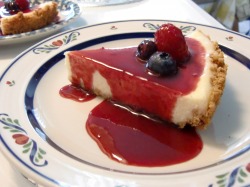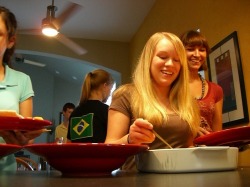Happy National Cheesecake Day! That's right, July 30th is the unofficial celebration of America's favorite cake, er I mean custard. Despite its name, cheesecake isn't really much of a cake at all. Cakes require flour; cheesecakes don't have that. Instead they're more of a custard as they are composed of mainly eggs, cream, and sugar.
Last week, I had a friend from France come and say with me. One night when we went out to dinner, she was excited to see Cheesecake on the dessert menu. Apparently, in France (or at least the southern part) they don't have cream cheese! Who would have thought that the country known for their over 360 different kinds of cheese, cream cheese is not among them. We of course had to make a cheesecake at home before she left.
After gently folding through the pages on the internet, we finally found a quick recipe for cheesecake. For you hardcore foodies (who aren't reading this because I know all two of my readers), I would not recommend using the recipe that we did. That being said, we did successfully satisfy our cheesecake craving.
I'll write more on this post in about a week. Hopefully I'll get internet in my apartment then. Hopefully This tiny bite of what's to come will wet your appetite for more on cheesecake.
Last week, I had a friend from France come and say with me. One night when we went out to dinner, she was excited to see Cheesecake on the dessert menu. Apparently, in France (or at least the southern part) they don't have cream cheese! Who would have thought that the country known for their over 360 different kinds of cheese, cream cheese is not among them. We of course had to make a cheesecake at home before she left.
After gently folding through the pages on the internet, we finally found a quick recipe for cheesecake. For you hardcore foodies (who aren't reading this because I know all two of my readers), I would not recommend using the recipe that we did. That being said, we did successfully satisfy our cheesecake craving.
I'll write more on this post in about a week. Hopefully I'll get internet in my apartment then. Hopefully This tiny bite of what's to come will wet your appetite for more on cheesecake.



